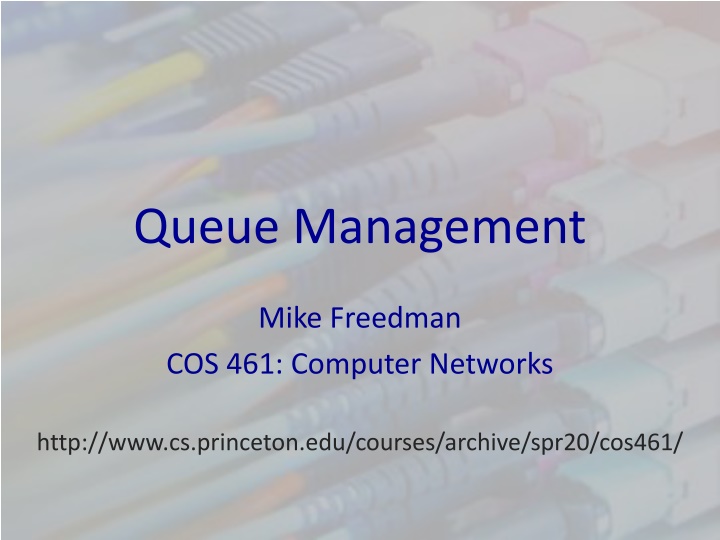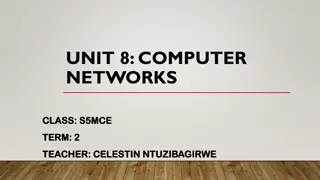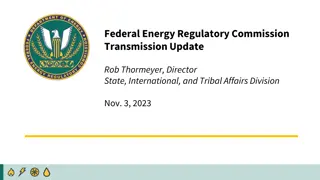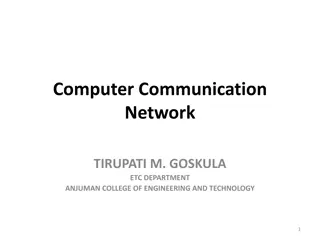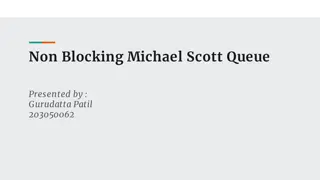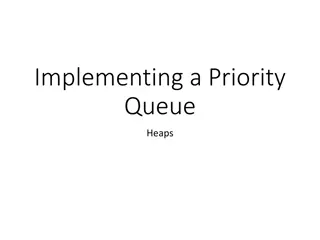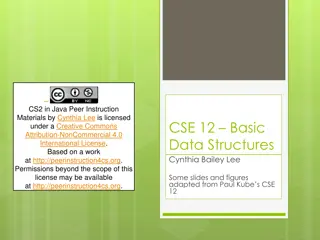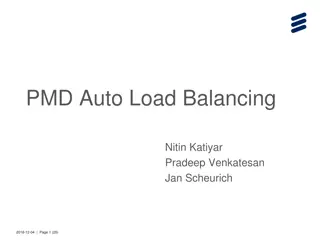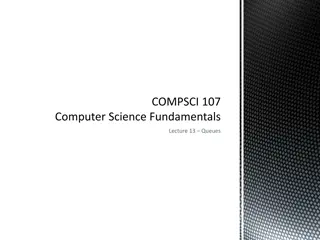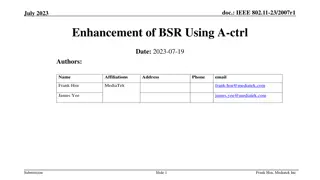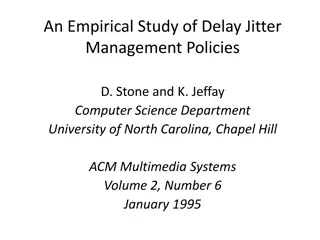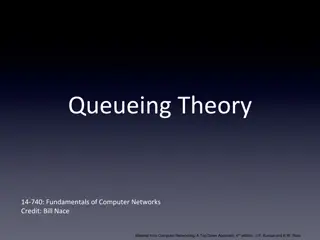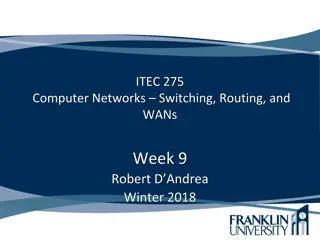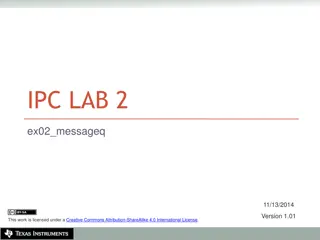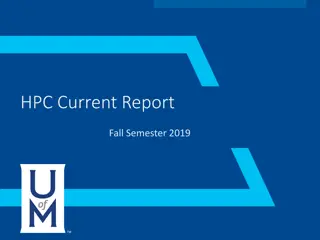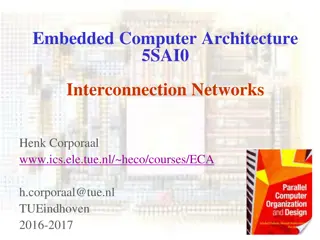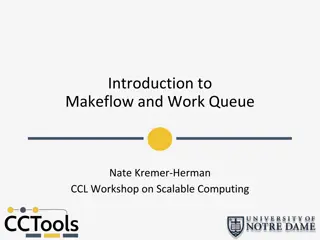Computer Networks Queue Management
This content covers various aspects of queue management in computer networks, including congestion control, packet queues, router architecture, line cards, queue management issues, FIFO scheduling, early congestion detection, and more. It delves into topics such as logical links, physical path addressing, packet handling, buffer management, and scheduling disciplines. Emphasis is placed on optimizing resource utilization, balancing throughput, delay, and fairness in data transmission.
Download Presentation

Please find below an Image/Link to download the presentation.
The content on the website is provided AS IS for your information and personal use only. It may not be sold, licensed, or shared on other websites without obtaining consent from the author.If you encounter any issues during the download, it is possible that the publisher has removed the file from their server.
You are allowed to download the files provided on this website for personal or commercial use, subject to the condition that they are used lawfully. All files are the property of their respective owners.
The content on the website is provided AS IS for your information and personal use only. It may not be sold, licensed, or shared on other websites without obtaining consent from the author.
E N D
Presentation Transcript
Queue Management Mike Freedman COS 461: Computer Networks http://www.cs.princeton.edu/courses/archive/spr20/cos461/
Last lecture: Congestion Control What can end-points do to collectively to make good use of shared underlying resources? name logical link ? ? physical path address 2
Today: Queue Management What can individual links do to make good use of shared underlying resources? name logical link physical path address ? 3
Router control plane Processor data plane Line card Line card Switching Fabric Line card Line card Line card Line card 5
Line Cards (Interface Cards, Adaptors) Packet handling Packet forwarding Buffer management Link scheduling Packet filtering Rate limiting Packet marking Measurement to/from link Transmit Receive lookup to/from switch 6
Queue Management Issues Scheduling discipline Which packet to send? Some notion of fairness? Priority? Drop policy When should you discard a packet? Which packet to discard? Goal: balance throughput and delay Huge buffers minimize drops, but add to queuing delay (thus higher RTT, longer slow start, ) 7
FIFO Scheduling and Drop-Tail Access to the bandwidth: first-in first-out queue Packets only differentiated when they arrive Access to the buffer space: drop-tail queuing If the queue is full, drop the incoming packet 8
Bursty Loss From Drop-Tail Queuing TCP depends on packet loss Packet loss is indication of congestion TCP additive increase drives network into loss Drop-tail leads to bursty loss Congested link: many packets encounter full queue Synchronization: many connections lose packets at once 10
Slow Feedback from Drop Tail Feedback comes when buffer is completely full even though the buffer has been filling for a while Plus, the filling buffer is increasing RTT making detection even slower Better to give early feedback Get 1-2 connections to slow down before it s too late! 11
Random Early Detection (RED) Router notices that queue is getting full and randomly drops packets to signal congestion Packet drop probability Drop probability increases as queue length increases Else, set drop probability f(avg queue length) Probability 0 1 Drop Average Queue Length 12
Properties of RED Drops packets before queue is full In the hope of reducing the rates of some flows Tolerant of burstiness in the traffic By basing the decisions on average queue length Which of the following are true? (Y) Drops packet in proportion to each flow s rate (M) High-rate flows selected more often (C) Helps desynchronize the TCP senders (A) All of the above 13
Properties of RED Drops packets before queue is full In the hope of reducing the rates of some flows Tolerant of burstiness in the traffic By basing the decisions on average queue length Which of the following are true? (Y) Drops packet in proportion to each flow s rate (M) High-rate flows selected more often (C) Helps desynchronize the TCP senders (A) All of the above 14
Problems With RED Hard to get tunable parameters just right How early to start dropping packets? What slope for increase in drop probability? What time scale for averaging queue length? RED has mixed adoption in practice If parameters aren t set right, RED doesn t help Many other variations in research community Names like Blue (self-tuning), FRED 15
Feedback: From loss to notification Early dropping of packets Good: gives early feedback Bad: has to drop the packet to give the feedback Explicit Congestion Notification Router marks the packet with an ECN bit Sending host interprets as a sign of congestion 17
Explicit Congestion Notification Needs support by router, sender, AND receiver End-hosts check ECN-capable during TCP handshake ECN protocol (repurposes 4 header bits) 1. Sender marks ECN-capable when sending 2. If router sees ECN-capable and congested, marks packet as ECN congestion experienced 3. If receiver sees congestion experienced , marks ECN echo flag in responses until congestion ACK d 4. If sender sees ECN echo , reduces cwnd and marks congestion window reduced flag in next packet 18
ECN Questions Why separate ECN experienced and echo flags? (Y) Detect reverse path congestion with experienced (M) Congestion could happen in either direction, want sender to react to forward direction (C) Both of the above 19
ECN Questions Why separate ECN experienced and echo flags? (Y) Detect reverse path congestion with experienced (M) Congestion could happen in either direction, want sender to react to forward direction (C) Both of the above Why echo resent & congestion window reduced ACK? (Y) Congestion in reverse path can lose ECN-echo, still want to respond to congestion in forward path (M) Only should apply backoff once per cwnd (C) Both of the above 20
ECN Questions Why separate ECN experienced and echo flags? (Y) Detect reverse path congestion with experienced (M) Congestion could happen in either direction, want sender to react to forward direction (C) Both of the above Why echo resent & congestion window reduced ACK? (Y) Congestion in reverse path can lose ECN-echo, still want to respond to congestion in forward path (M) Only should apply backoff once per cwnd (C) Both of the above 21
First-In First-Out Scheduling First-in first-out scheduling Simple, but restrictive Example: two kinds of traffic Voice over IP needs low delay E-mail is not that sensitive about delay Voice traffic waits behind e-mail 23
Strict Priority Multiple levels of priority Always transmit high-priority traffic, when present Isolation for the high-priority traffic Almost like it has a dedicated link Except for (small) delay for packet transmission But, lower priority traffic may starve 24
Weighted Fair Scheduling Weighted fair scheduling Assign each queue a fraction of the link bandwidth Rotate across queues on a small time scale 50% red, 25% blue, 25% green 25
Weighted Fair Scheduling If non-work conserving (resources can go idle) Each flow gets at most its allocated weight WFQ is work-conserving Send extra traffic from one queue if others are idle Results in (Y) higher or (M) lower utilization than non- work conserving? WFQ results in max-min fairness Maximize the minimum rate of each flow 26
Max-Min Fairness Maximize the minimum rate of each flow 1. Allocate in order of increasing demand 2. No flow gets more than demand 3. The excess, if any, is equally shared 8 Rate Demanded/Allocated 10 10 10 2 8 2 Total = 6 2 2 2 Flows sorted by demand 27 27
Max-Min Fairness Maximize the minimum rate of each flow 1. Allocate in order of increasing demand 2. No flow gets more than demand 3. The excess, if any, is equally shared = min( , ) r f C 8 Rate Demanded/Allocated 10 i 4 i 10 10 4 2 2 8 Total = 10 f = 4: min(8, 4) = 4 min(10, 4) = 4 min(2, 4) = 2 2 2 4 2 4 2 Flows sorted by demand 28 28
Weighted Fair Queueing Link 1, ingress Link 1, egress Link 2, egress Link 2, ingress flow 1 flow 2 Classifier Scheduler Link 3, egress Link 3, ingress flow n 29 WFQ slides credit: Nick McKeown (Stanford)
Bit-by-Bit Fair Queueing Question: What is a flow ? Flow 5-tuple: protocol, IP source/dest, port src/dest Question: How can we give weights? Protocol class, bit markings, prefixes, etc. Flow 1 Bit-by-bit round robin Classification Flow N 30
Bit-by-Bit Weighted Fair Queueing Flows allocated different rates by servicing different number of bits for each flow during each round. w1 = 0.1 w2 = 0.3 1 R1 C w3 = 0.3 w4 = 0.3 Order of service for the four queues: f1, f2, f2, f2, f3, f3, f3, f4, f4, f4, f1, 31
Packet vs. Fluid System Bit-by-bit FQ is not implementable: In real packet-based systems: One queue is served at any given time Packet transmission cannot be preempted Goal: A packet scheme close to fluid system Bound performance w.r.t. fluid system 32
First Cut: Simple Round Robin Serve a packet from non-empty queues in turn Lets assume all flows have equal weight Variable packet length get more service by sending bigger packets Unfair instantaneous service rate (esp. with variable weights) E.g. 500 flows: 250 with weight 1, 250 with weight 10 Each round takes 2,750 packet times What if a packet arrives right after its turn ? 33
Packet-by-packet Fair Queuing (Weighted Fair Queuing) Deals better with variable size packets and weights Key Idea: 1. Determine the finish time of packets in bit-by- bit system, assuming no more arrivals 2. Serve packets in order of finish times 34
Implementing WFQ Challenge: Determining finish time is hard Idea: Don t need finish time. Need finish order. The finish order is a lot easier to calculate. 35
Finish order Increasing Li/wi In what order do the packets finish? L1 w1 = 0.1 1 L2 w2 = 0.3 C R1 w3 = 0.3 L3 Order of service for the four queues: f1, f2, f2, f2, f3, f3, f3, f4, f4, f4, f1, w4 = 0.3 L4 Does not change with future packet arrivals! 36
Bit-by-bit System Round L1 w1 = 0.1 w1 = 1 1 L2 w2 = 0.3 w2 = 3 C R1 w3 = 0.3 w3 = 3 L3 Order of service for the four queues: f1, f2, f2, f2, f3, f3, f3, f4, f4, f4, f1, w4 = 0.3 w4 = 3 L4 Round One complete cycle through all the queues sending wibits per queue Question: How long does a round take? 37
Bit-by-bit System Round L1 w1 = 0.1 w1 = 1 1 L2 w2 = 0.3 w2 = 3 C R1 w3 = 0.3 w3 = 3 L3 Order of service for the four queues: f1, f2, f2, f2, f3, f3, f3, f4, f4, f4, f1, w4 = 0.3 w4 = 3 L4 Round One complete cycle through all the queues sending wibits per queue dR dt C R(t) = # of rounds at time t C = link rate B(t) = set of backlogged flows = wj j B(t) 38
Bit-by-bit System Round L1 w1 = 0.1 w1 = 1 1 L2 w2 = 0.3 w2 = 3 C R1 w3 = 0.3 w3 = 3 L3 Order of service for the four queues: f1, f2, f2, f2, f3, f3, f3, f4, f4, f4, f1, w4 = 0.3 w4 = 3 L4 Round One complete cycle through all the queues sending wibits per queue Question: How many rounds does it take to serve a packet of length L from flow i? 39
Bit-by-bit System Round L1 w1 = 0.1 w1 = 1 1 L2 w2 = 0.3 w2 = 3 C R1 w3 = 0.3 w3 = 3 L3 Order of service for the four queues: f1, f2, f2, f2, f3, f3, f3, f4, f4, f4, f1, w4 = 0.3 w4 = 3 L4 Round One complete cycle through all the queues sending wibits per queue Packet of length L takes L/wi rounds to serve 40
Round (aka. Virtual Time) Implementation of WFQ Question: What is finish round of kth packet Fik? 41
Round (aka. Virtual Time) Implementation of WFQ Assign a start/finish round to each packet at arrival serve packets in order of finish rounds Suppose kth packet of flow i arrives at time a Finish round of (k-1)th packet Start round of kth packet k-1 k k-1 Fi (Flow i backlogged) k= Si R(a) k Round number at time a (Flow i empty) 42
Putting it All Together For kth packet of flow i arriving at time a: k-1,R(a)) k=max(Fi Si k k+Li i w k= Si Fi Question: How to compute R(a)? Simple approximation: Set R(a) to start or finish round of packet currently in service dR dt C = wj j B(t) 43
Implementation Trade-Offs FIFO One queue, trivial scheduler Strict priority One queue per priority level, simple scheduler Weighted fair scheduling One queue per class, and more complex scheduler 44
Distinguishing Traffic Applications compete for bandwidth E-mail traffic can cause congestion/losses for VoIP Principle 1: Packet marking So router can distinguish between classes E.g., Type of Service (ToS) bits in IP header 46
Preventing Misbehavior Applications misbehave VoIP sends packets faster than 1 Mbps Principle 2: Policing Protect one traffic class from another By enforcing a rate limit on the traffic 47
Subdividing Link Resources Principle 3: Link scheduling Ensure each application gets its share while (optionally) using any extra bandwidth E.g., weighted fair queuing 48
Reserving Resources, and Saying No Traffic cannot exceed link capacity Deny access, rather than degrade performance Principle 4: Admission control Application declares its needs in advance Application denied if insufficient resources available 49
Quality of Service (QoS) Guaranteed performance Alternative to best-effort delivery model QoS protocols and mechanisms Packet classification and marking Traffic shaping Link scheduling Resource reservation and admission control Identifying paths with sufficient resources 50
